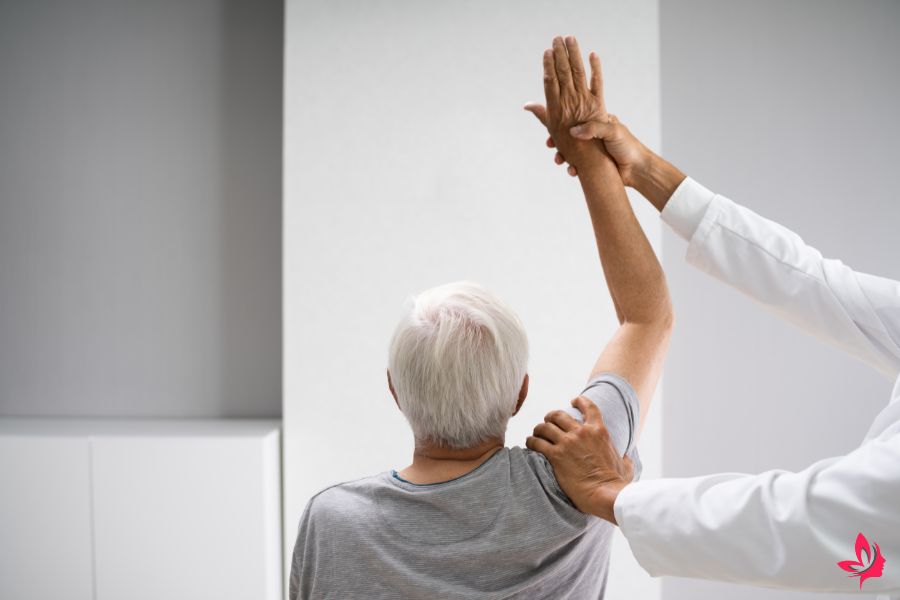In-home physical therapy for seniors brings professional rehabilitation right to the places where comfort and familiarity matter most.
Licensed physical therapists now deliver high-quality care in a senior’s home, which often leads to better results and happier patients than standard clinic visits.
This guide examines how personalized care plans enhance physical health, how therapists assess each individual’s needs, and the progression from initial evaluation to long-term independence through tailored in-home therapy.
Why In-Home Physical Therapy for Seniors Enhances Physical Health

In-home physical therapy for seniors offers targeted treatment that meets individual needs and removes common obstacles to care. This approach yields tangible improvements in strength, balance, and mobility, all within the comfort of your own home.
How Personalized Physical Therapy Sessions in Your Home Improve Muscle Strength
At-home therapy sessions zero in on each senior’s muscle weaknesses and personal strength goals. A licensed therapist starts by assessing which muscle groups need the most attention.
Targeted Strength Training Programs:
- Upper body exercises for reaching and lifting
- Lower body workouts for walking and stairs
- Core stability for posture and balance
- Resistance training with household items or portable gear
The therapist develops a customized treatment plan that evolves as strength improves. Practicing exercises at home allows seniors to work in the same space where they perform daily tasks.
This method helps older adults build functional strength, making everyday movement easier. The National Institute on Aging recommends that seniors engage in strength training at least twice a week.
Addressing Mobility Issues and Limited Mobility with Balance Training
Balance training at home tackles the exact challenges seniors face in their routines. Therapists assess fall risks in the home environment, where most accidents actually occur.
Balance Training Components:
- Standing balance exercises
- Walking and turning for dynamic balance
- Coordination drills for tougher moves
- Reaction training for surprises
Gait training helps seniors walk safely on their own floors, stairs, or even outside. Therapists identify hazards and teach specific movement strategies tailored to each person’s living space.
Home-based balance work can cut fall risk by up to 23%, according to the Centers for Disease Control and Prevention. For daily life, that’s a big deal.
Supporting Older Adults with Chronic Conditions at Home
Chronic health issues need steady management, and home-based therapy does that better than a clinic. Therapists work with seniors dealing with Parkinson’s, arthritis, diabetes, or heart problems.
Working at home, therapists can see firsthand how pain or fatigue affects daily tasks. They devise practical ways to manage symptoms while engaging in everyday activities.
Chronic Condition Management:
- Pain relief through manual therapy
- Energy-saving tips for daily life
- Training on adaptive equipment for independence
- Custom exercise plans for changing symptoms
This approach helps seniors maintain their physical abilities while managing ongoing health issues. Home health services bring steady support for complex medical needs.
Greater Comfort of Your Own Home Speeds Recovery
Recovery often progresses more quickly when therapy takes place in a familiar setting, free from the hassles of transportation or sterile clinics. Being at home can ease anxiety and help with healing.
Seniors get to practice new movements right away in their real routines. Hands-on practice builds confidence and reinforces learning much faster than a clinic can.
Family members can watch sessions and pick up tips for helping out between visits. It’s a team effort that keeps care going even after the therapist leaves.
In-Home Therapy as a Cost-Effective Rehabilitation Option
Medicare Part B pays for in-home physical therapy if you meet the medical requirements. That means most seniors can access these services without incurring significant out-of-pocket expenses.
Cost Benefits:
- No need to pay for rides or spend time traveling
- Less burden and cost for caregivers
- Fewer pricey ER visits
- Earlier discharge from expensive care facilities
Because home therapy addresses real-world problems directly, it often requires fewer visits to achieve results. That efficiency lowers healthcare costs while improving physical health.
Crafting a Personalized Care Plan for Optimal Results

A thorough assessment forms the backbone of effective treatment. Working closely with healthcare professionals ensures that care meets each person’s needs, and Medicare Part B helps cover the associated costs.
Family involvement can also make a significant difference in the recovery process.
Conducting a Comprehensive Assessment of Your Condition at Home
Therapists start by reviewing your medical history, current abilities, and any mobility problems. They check muscle strength, flexibility, and balance during the first visit.
If you have chronic conditions like Parkinson’s or a recent joint replacement, they’ll factor that in. Therapists also look for safety hazards and obstacles around the home.
Key Assessment Areas:
- Physical Function: Strength, flexibility, coordination
- Daily Activities: Walking, stairs, transfers
- Pain Levels: Where, how strong, how often
- Fall Risk: Balance, walking stability, home safety
They document starting points so everyone can track progress. This in-depth look enables therapists to select the most suitable treatment options for each individual.
Witnessing how someone moves and handles daily tasks in their own space provides a much clearer picture than any clinic could ever offer.
Collaborating with In‑Home Therapists on a Personalized Treatment Plan
Expert therapists use assessment results and personal goals to build a custom plan. The treatment plan addresses specific challenges and considers lifestyle factors.
Together, therapists and patients set realistic short-term and long-term goals, such as walking farther or climbing stairs more easily.
Treatment Plan Components:
- Targeted exercises
- Pain management tools
- Safety tips
- Equipment recommendations
- Progress checkpoints
Therapists stay in touch and adjust the plan as needed. Patients have a say in goal-setting, which helps maintain high motivation and increases the likelihood that they’ll stick with therapy.
Integrating Occupational Therapy, Speech Therapy & Physical Therapy Sessions
Combining different therapy types—physical, occupational, and speech—gives older adults the best shot at recovery. Physical therapy focuses on building strength and mobility, while occupational therapy helps individuals with everyday tasks.
Speech therapy steps in for stroke recovery or neurological issues. This all-hands approach covers every angle of functional recovery.
Therapy Coordination Benefits:
- Builds a wide range of skills
- Reduces overlap and confusion
- Keeps providers on the same page
- Makes scheduling easier
Team members share updates and coordinate visits to avoid mixed messages or wasted effort. Practicing new skills at home allows patients to apply what they have learned in real-life situations immediately.
Engaging Family Members for Emotional Support and Daily Activities Assistance
Family support can make or break a rehab plan. When loved ones attend therapy sessions, they learn how to assist with exercises and promote safe movement.
Caregivers pick up safe techniques and fall prevention strategies. Practical training helps everyone stay safe.
Family Support Roles:
- Supervising exercises
- Reminding about medication
- Helping with transportation
- Offering encouragement
- Watching for safety risks
Therapists teach families to recognize warning signs, so they know when to seek help. This knowledge can prevent setbacks and keep recovery on track.
When families are involved, patients tend to stick with therapy and achieve better results. It’s comforting to have someone in your corner, especially on tough days.
Leveraging Medicare Part B and Insurance for Home Health Care
Medicare Part B covers in-home therapy if you meet the homebound rules from the Centers for Medicare & Medicaid Services. Coverage includes evaluations, therapy sessions, and any necessary medical equipment.
Most insurance companies want a doctor’s referral and proof that therapy is medically necessary. Sometimes, you may need pre-approval for more extensive treatment plans.
Coverage Requirements:
- Doctor certifies you’re homebound
- Proof you need skilled therapy
- Treatment plan with clear goals
- Regular progress updates
Check with your insurance for the details before starting. Knowing about copays and session limits helps avoid surprises.
Working with Medicare-certified agencies ensures smooth billing and reduces the number of denied claims. That means fewer headaches and lower costs for you.
Daily Life Through In-Home Therapy: From Assessment to Long-Term Independence

In-home physical therapy provides seniors with care that addresses pain, enhances mobility, and makes their home safer. This approach transforms daily struggles into opportunities for independence and lays the groundwork for long-term support.
Using Hands-On Techniques and Electrical Stimulation to Manage Chronic Pain
Licensed therapists use hands-on methods and electrical stimulation to help seniors manage chronic pain that makes daily life tough. Manual therapy encompasses joint mobilization, soft tissue massage, and trigger point release to alleviate muscle tension and enhance blood flow.
Electrical stimulation devices send controlled currents to specific muscles. This treatment can help reduce swelling, block pain signals, and accelerate healing. Therapists tweak the intensity to fit each person’s needs and health conditions.
Common pain management techniques include:
- Transcutaneous electrical nerve stimulation (TENS)
- Neuromuscular electrical stimulation (NMES)
- Ultrasound therapy
- Heat and cold packs
These treatments target stubborn problems like arthritis, fibromyalgia, and pain after surgery. The CDC actually recommends physical therapy as a first step for managing arthritis pain.
Seniors receive care plans that combine and match various pain relief methods. In my experience, this combined approach beats single-method treatments for complex pain issues most of the time.
Strength Training, Range of Motion & Gait Training for Functional Mobility
Strength training targets major muscle groups to boost physical function and help prevent weakness. Therapists create progressive resistance plans using resistance bands, light weights, or bodyweight exercises that cater to each person’s abilities.
Range of motion exercises help keep joints flexible and combat stiffness. Shoulder circles, ankle rotations, and gentle stretches—done daily—can make everyday things like dressing and bathing easier.
Key gait training elements:
- Step length coordination
- Balance during walking
- Proper foot placement
- Improving walking speed
Gait training helps individuals address walking issues that can compromise mobility and safety. Therapists observe how someone walks and intervene to correct movements that increase the risk of falls. This approach often helps after joint replacements or for those dealing with Parkinson’s disease.
Functional mobility exercises mimic daily activities—think climbing stairs, standing up from chairs, or reaching overhead. Practicing these movements can build confidence and make real life feel less daunting.
Preventing Falls with Balance Training and Home Environment Modifications
Balance training cuts fall risk by focusing on stability and coordination. Therapists assess each person’s balance and create customized routines to address weak areas.
Some essential balance exercises:
- Standing on one leg
- Heel-to-toe walking
- Weight shifting
- Standing on unstable surfaces
Home modifications can remove hazards that often lead to falls. Therapists walk through living spaces, spot risky areas, and suggest fixes that make a real difference.
Smart changes include adding grab bars in bathrooms, increasing hallway lighting, removing loose rugs, and ensuring walkways remain clear. The National Institute on Aging has a handy guide for making homes safer.
Physical therapy sessions often include environmental awareness. Seniors learn to navigate their homes safely, even when facing mobility issues or physical limitations.
Adapting Physical Challenges into Daily Routines for Independence
In-home therapists help seniors incorporate therapeutic exercises into their daily routines without disrupting their schedules. This makes it much easier to stick with therapy in the long term.
Mornings often begin with gentle stretches and range of motion exercises. These exercises can help loosen up stiff joints after a night’s sleep, and you don’t even have to get out of bed to do some of them.
Ways to fit exercise into daily life:
- Move during commercial breaks
- Stretch while cooking
- Practice balance on the phone
- Use household items for strength training
Afternoons could focus on strength and functional movements. Therapists often suggest using soup cans or water bottles as weights—simple, yet effective.
Evenings are a good time for relaxation and gentle mobility work. This not only keeps joints flexible but can also aid in improving sleep.
Planning for Long-Term Care Options and Ongoing In-Home Care
Healthcare providers team up with families to develop care plans that evolve as needs change. Initial evaluations establish a baseline and help identify potential needs that may arise in the future.
Long-term care might mean moving from intensive therapy to a maintenance plan. Medicare Part B can help cover ongoing services if a healthcare professional determines they are medically necessary.
Care transition steps:
- Slowly reducing therapy sessions
- Training family caregivers
- Connecting with community resources
- Regular progress check-ins
Home health services often coordinate with occupational and speech therapists when an individual requires more comprehensive care. This team effort encompasses multiple aspects of health simultaneously.
Ongoing support helps seniors hold onto progress made during therapy. Regular check-ins, updated exercise plans, and tweaks to equipment all help prevent setbacks.
Frequently Asked Questions
Seniors considering in-home physical therapy often have questions about safety, effectiveness, and how to make the most of it. Knowing your exercise limits, when to rest, and how to time activities can significantly enhance the success of your rehabilitation.
Absolutely—physical therapy works well at home with guidance from a licensed therapist. Therapists visit, bring portable equipment, and tailor each session to fit your space and needs.
Home-based physical therapy yields results that match or even surpass those of clinic-based treatments. Some studies report better outcomes after knee surgery when patients recover at home instead of traveling to appointments.
Home therapy eliminates the transportation hassle, which is particularly significant for seniors with mobility issues. Therapists can tailor exercises to your specific environment and daily routines.
The 80/20 rule states that approximately 80% of recovery comes from regular daily activities and home exercises, while only 20% comes from formal therapy sessions. This highlights the importance of staying active between appointments.
For seniors, sticking with home exercise routines often yields better results than relying solely on therapist visits. It’s a reminder to take charge of your own rehab journey.
Yes, overdoing physical therapy can backfire—leading to overuse injuries, swelling, or slower healing. Seniors are particularly at risk due to slower muscle recovery and changes in their joints.
If you notice muscle soreness that won’t quit after 48 hours, more joint pain, or constant fatigue, your body’s asking for a break. These are signs to ease up and allow more recovery time.
Therapists monitor your response and adjust the plan to fit your health and progress. They’ll set safe limits tailored to your condition.
A home exercise program is a set of exercises designed by your physical therapist for you to perform on your own between visits. These routines target specific problems, such as weak muscles, poor balance, or stiff joints.
Programs are personalized and updated as you improve or your goals change. Most use common household items, and therapists provide clear instructions and safety tips to help you get it right.
Written guides, pictures, and repetition goals make it easier to follow along and stay safe while exercising independently.
Yes—rest days matter for healing and muscle recovery, especially for seniors. Most therapy plans include rest days to avoid overuse and give your body time to adapt.
Active rest can involve light walking or gentle stretching, rather than complete downtime. The ideal rest schedule depends on your health, the intensity of your therapy, and your rate of recovery.
Most seniors do well with one or two rest days each week, but if pain or fatigue persists, it’s wise to take more time off as recommended by your provider.
The best time for physical therapy depends on the person. Many seniors seem to perform better in the late morning or early afternoon, once their joints loosen up and their energy levels pick up a bit.
That morning stiffness most seniors feel tends to fade after some gentle movement. So, waiting until after breakfast or a short walk can make exercises less uncomfortable.
Sticking to a consistent time each day helps build a routine. It’s easier to keep up with therapy when it’s part of your daily rhythm.




